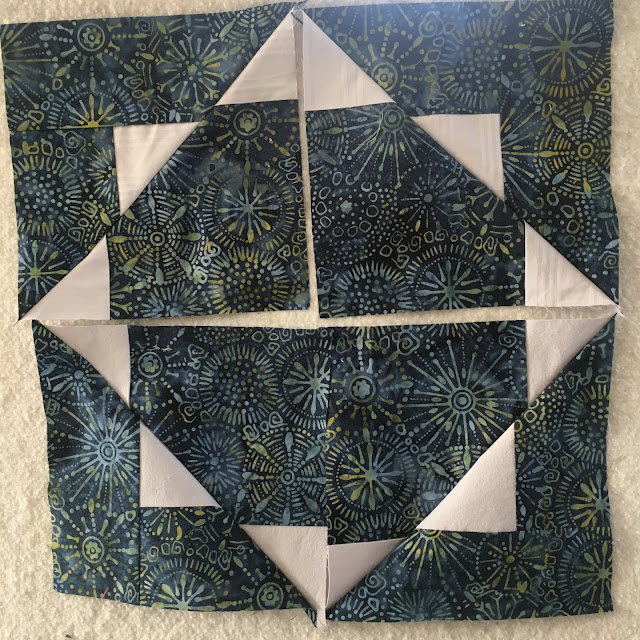by Linda Theil
I saw this block on my friend Kathy Schmidt's Quirks, Ltd. weblog and asked her for the directions. She pointed me to The Joyful Quilter tutorial. This pattern is one of those complex-looking, but easy to sew, Twenty-first Century blocks made by sewing a basic block, cutting the basic block, then sewing the pieces together with other blocks sewn and cut in the same way. I've seen several patterns for a complete quilt using this block offered for sale on the Internet.
Although it sounds complex, this technique makes creating a multi-pieced block very fast and easy. I like this block because when sewn in multiples, an unexpected circle appears in the design, as shown below.
- a 6.5-inch square,
- a 6.5 x 3.5-inch rectangle,
- and a 3.5 x 10-inch rectangle.
After sewing this basic block, trim the basic block to nine-inches square.
To complete the block, turn each basic block on the diagonal. Put your ruler perpendicular, through the top and bottom points of the block. Make sure your ruler delineates a small arrow in the center of one-half of your block. This is very important because it is easy to mistake your placement and cut from point-to-point through the center of the fabric points created by your piecing, ruining your block for this design. Cut the block in half using a rotary cutter.
Cut both sets of pieced blocks, then rearrange into new blocks showing one corner and one diamond shape, revealing a line of contrasting triangles between, as shown below. Sew all four blocks in this configuration, then arrange with squares meeting in the center, and with the corners creating all four corners of your circular motif, as shown in subsequent photos below:
Seam the top two pieces vertically, then the bottom two pieces vertically. Then sew the top and bottom pieces together with a horizontal seam.
If you make eight blocks, you can arrange all the same centers and corners together to create a contrasting star -- eight blocks will make one light star and one dark star.
Update March 19, 2021
Finished, flannel-backed quilt. Long-armed by Laura Jarvis of KootsieQuilting in Stockbridge, MI.
Resources
Quirks Ltd. "Wrapping it up" Jan. 25, 2121 at https://quirksltd.wordpress.com/2021/01/25/wrapping-it-up-already/ by Kathy Schmidt, Tecumseh, MI
The Joyful Quilter "Tutorial Tuesday -- Magic Star Tutorial with Tiffany" March 24, 2020 at https://thejoyfulquilter.blogspot.com/2020/03/magic-star-tutorial-with-tiffany.html by Joyful Quilter, Hillsborough NC















Comments